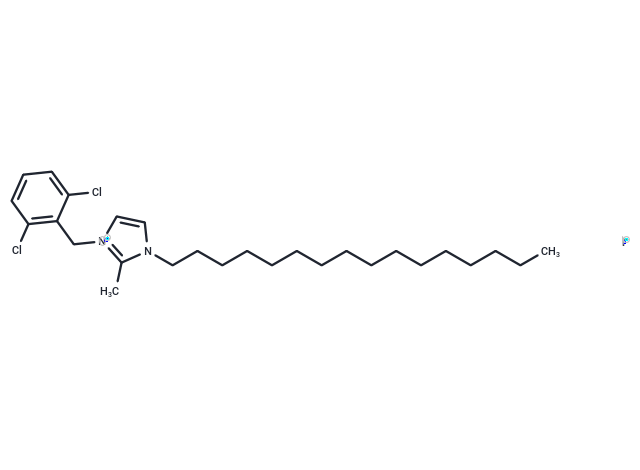Shopping Cart
Remove All Your shopping cart is currently empty
Your shopping cart is currently empty
Aldometanib (LXY-05-029) is an orally active aldolase inhibitor that prevents FBP from binding to v-ATPase-associated aldolase and activates lysosomal AMPK, useful in metabolic homeostasis research [1].

| Pack Size | Price | USA Warehouse | Global Warehouse | Quantity |
|---|---|---|---|---|
| 1 mg | $37 | In Stock | In Stock | |
| 5 mg | $83 | In Stock | In Stock | |
| 10 mg | $132 | In Stock | In Stock | |
| 25 mg | $288 | In Stock | In Stock | |
| 50 mg | $427 | In Stock | In Stock | |
| 100 mg | $632 | - | In Stock | |
| 200 mg | $882 | - | In Stock | |
| 1 mL x 10 mM (in DMSO) | $113 | In Stock | In Stock |
| Description | Aldometanib (LXY-05-029) is an orally active aldolase inhibitor that prevents FBP from binding to v-ATPase-associated aldolase and activates lysosomal AMPK, useful in metabolic homeostasis research [1]. |
| In vitro | Aldometanib (0-1000 nM; 2 h) activates AMPK through preventing aldolase from binding to FBP to engender a pseudo-starvation signal [1]. Western Blot Analysis [1] Cell Line: Mouse primary hepatocytes, MEFs cells Concentration: 0-1000 nM Incubation Time: 2 h Result: Activated AMPK in mouse embryonic fibroblasts (MEFs) and mouse primary hepatocytes cells. Immunofluorescence [1] Cell Line: MEFs cells Concentration: 5 nM Incubation Time: 2 h Result: Inhibited TRPVs and induces AXIN lysosomal translocation. |
| In vivo | Aldometanib, administered orally at dosages ranging from 0-10 mpk, effectively reduces blood glucose levels in lean mice and, when given at 2-10 mpk twice daily for a week, mitigates blood glucose and ameliorates fatty liver in obese hyperglycemic mice. Additionally, it addresses fatty liver and nonalcoholic steatohepatitis issues, and a regimen of 2 mpk twice daily over a month alleviates liver fibrosis in NASH mice. Moreover, Aldometanib extends the lifespan of C. elegans through the lysosomal pathway when administered orally at 0-50 μM for up to 50 days. In lean mice, dosages of 0-10 mpk lower fasting blood glucose, enhance glucose tolerance, and promote muscular TBC1D1 phosphorylation for glucose uptake. In obese hyperglycemic mice, a week-long administration of 2-10 mpk effectively lowers blood glucose, decreases hepatic TAG, and enhances insulin sensitivity through muscular AMPK dependencies, also diminishing fat mass. For NASH mice, a month-long administration of 2 mpk results in the reduction of NASH diagnostic histological scores, decreased hepatic cell apoptosis, reduced inflammatory liver responses, and improved glucose tolerance. In C. elegans, dosages of 0-50 μM improve oxidative stress resistance and bolster mitochondrial functions, while for C57BL/6 mice, administering 100 μg/mL orally rejuvenates muscle function and extends lifespan by increasing NAD+ levels and mitochondrial oxidative respiration. |
| Synonyms | Compound IA-47 (Br- base 2246625-81-8) |
| Molecular Weight | 593.46 |
| Formula | C27H43Cl2IN2 |
| Cas No. | 2904601-67-6 |
| Smiles | CC1=[N+](C=CN1CCCCCCCCCCCCCCCC)CC2=C(Cl)C=CC=C2Cl.[I-] |
| Color | White |
| Appearance | Solid |
| Storage | Powder: -20°C for 3 years | In solvent: -80°C for 1 year | Shipping with blue ice/Shipping at ambient temperature. | |||||||||||||||||||||||||||||||||||
| Solubility Information | DMSO: 131.25 mg/mL (221.16 mM), Sonication is recommended. | |||||||||||||||||||||||||||||||||||
Solution Preparation Table | ||||||||||||||||||||||||||||||||||||
DMSO
| ||||||||||||||||||||||||||||||||||||
| Size | Quantity | Unit Price | Amount | Operation |
|---|

Copyright © 2015-2025 TargetMol Chemicals Inc. All Rights Reserved.